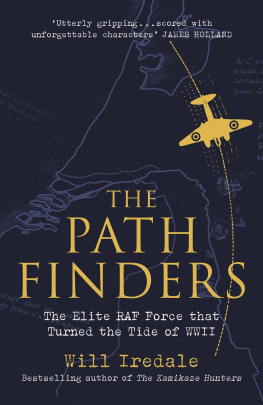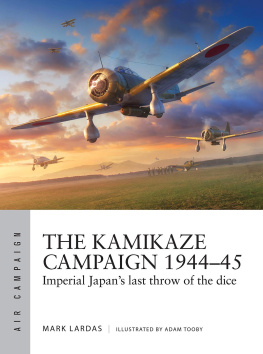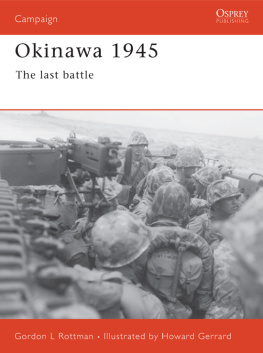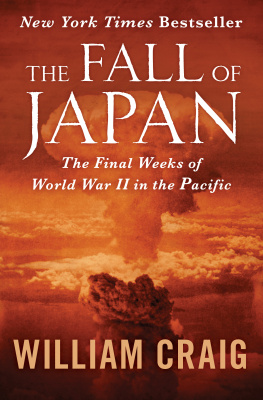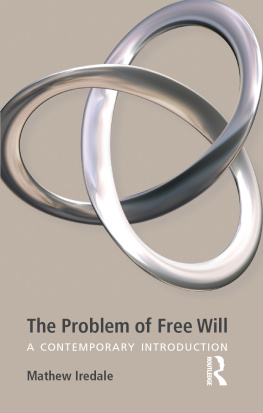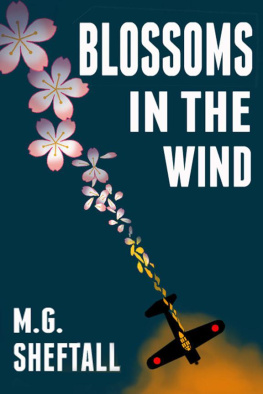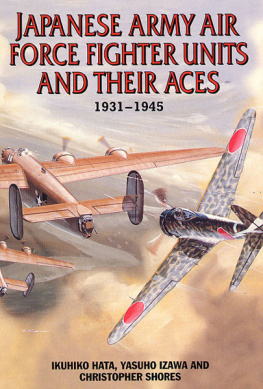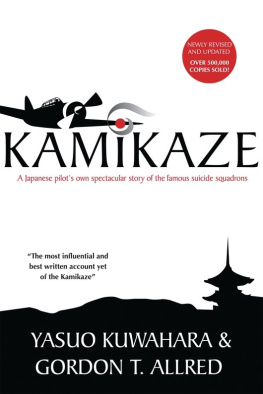I couldnt have written this book without the expertise, support and kindness of many people. Firstly, to the former airmen and sailors of the British Pacific Fleet, who were always willing to spare their time and remained patient and courteous, answering my various questions via letter, email and on the phone.
Keith Quilters remarkable story was not only the trigger for the book but formed the basis of a wonderful friendship. Accompanying him back to Japan after sixty-seven years was an honour, and we both appreciated the kindness shown by Andy Edney, the defence attache of the British embassy in Tokyo, and his team.
Both Keith and Chris Cartledge took time to read through various drafts of the book, pointing out glaring errors and offering advice. Any errors that do remain are, of course, entirely my own. Seventy years after leaving the congregation at St Vincent clawing for the note which wasnt forthcoming, I was proud to have Chris playing the church organ so beautifully at my wedding.
Ive been lucky enough to use a number of private diaries, letters and memoirs. My thanks to Ken Wards son Martin and his family, and to Wally Stradwicks great-niece Becky and her family. The book would not have been possible without these vital documents.
Many wives, families and companions of veterans kept me fed and watered in my various enjoyable visits around the country. Thank you to Joyce Hawkes, Mary-Ann Bennett, Liz Beldam, and Ken Wards companion Joyce. I am also grateful to Steve Kerridge, Freddie Hockleys nephew, not only for sparing the time to talk to me about his uncle, but also for his generous hospitality in putting me up for the night at his guesthouse in Norfolk.
I was provided with vital background information by Wendy Larkin whose remarkable father Buster Hallett deserves a book of his own and Polly Thellusson, with whom I spent a wonderful few hours at the National Arboretum, where she shared some personal insights into her father. Thanks also to Felicity Winch, Mike Draper of the Fleet Air Arm Officers Association and Ann Richards, Honorary Reunion Secretary of the HMS Indefatigable Association, who were able to track down veterans for me to interview.
My thanks to Harry Wallop, who introduced me to Veronique Baxter at David Higham. Veronique and her assistant Laura West were a pillar of strength and made it all happen. Many thanks too to Georgina Morley at Macmillan, for taking a leap of faith in going for the idea, and Zennor Compton and Fraser Crichton for their brilliant and patient editing, turning what was a very rough and unready first draft into something rather more palatable. I appreciate the time spared by Miwako Harty and Lis van Lynden for translating various documents.
Many hours researching this book were spent in various archives. I was lucky enough to have some wonderful guidance from the late Rod Suddaby at the Imperial War Museum. The staff at the National Archives in Kew were always on hand to provide advice. Barbara Gilbert, Catherine Cooper and Rachael Casey at the Fleet Air Arm Museum have been patient and professional. A visit to the museum archive is a treat.
This book was a labour of love, researched and written mainly at weekends or late into the evenings. In addition to the wonderful support from my family, finally my gratitude must go to my wife Jo, who provided not just support but also injected wisdom and clarity into my often overloaded brain. Writing a book is by its very nature a selfish act. Jos patience rarely faltered, despite most other things at home taking second preference for so long. I promise Ill get on and paint those shelves now, darling.
A common reaction during the Second World War when a man dressed in the uniform of the Royal Navy said he was an airman was surprise. Dont be silly. Sailors dont fly, one naval aviator was told in disbelief when he answered a question about the gold wings on his sleeve. Yet by the closing months of the war these flying sailors were spearheading the largest fleet the Royal Navy had assembled throughout the entire war, flying hundreds of dangerous daylight missions over the skies of mainland Japan in aircraft marked with the roundels of the Fleet Air Arm (FAA), the air branch of the Royal Navy.
This marked the culmination of events which can be traced back to 1931, when the Japanese seized Manchuria and forged into China six years later to begin the bloody expansion of an empire they perceived to be their right; after all, Western nations including Britain had enjoyed such empires for centuries. Under the rule of Emperor Hirohito, throughout the 1930s Japan became increasingly isolated, withdrawing from the League of Nations in 1933. Its military machinations in China and the subsequent appalling treatment of the Chinese people triggered a series of trade restrictions and sanctions, primarily from the outraged Americans, who banned the export to Japan of aviation fuel, oil and iron, with the failed objective of forcing the Japanese government into a negotiated settlement with China.
In September 1940 Japan signed the Tripartite Pact with Germany and Italy, further worsening relations with the United States. At the same time the shadow of Nazi Germany was falling over Europe. With Britains defeat and total German victory imminent, Japanese strategy focused on extending its territory in the Far East. By July 1941, 80 per cent of Japans oil supplies had been cauterized by international sanctions. By sweeping south-west through east Asia, via Malaya and Singapore, the Japanese top brass planned to capture the British and Dutch oil and rubber resources in south-east Asia, securing their left flank by neutralizing the American fleet at its Pacific headquarters in Pearl Harbor, 4,000 miles from Tokyo, in Hawaii. Tokyo could not afford total war with America, which annually produced twelve times as much steel and five times as many ships as Japan, but it believed it would be able to secure a negotiated settlement.
Britain had opened its vast naval base in Singapore three years earlier, puffing out its chest and signalling to the world it still had the most powerful navy and intended to use it to protect its valuable eastern empire. The reality was, however, that by 1938 the Royal Navys focus had turned to European waters, where Nazi Germany was the most immediate threat.
The British hoped that American pressure would keep Japan in check in the Far East. However, to reassure the Dutch government-in-exile in London, whose vast East Indies riches of oil and rubber were vulnerable, and Australia, which was becoming increasingly anxious, the Admiralty dispatched its new battleship Prince of Wales and an elderly battlecruiser, Repulse, to Singapore.
On 8 December 1941 the predicted Japanese onslaught across the Far East began, with simultaneous attacks on the Malay Peninsula, Guam, the Philippines, Hong Kong and Singapore. Two days later Royal Navy Force Z comprising Prince of Wales, Repulse and four destroyers was attacked by Japanese bombers and torpedo bombers in the South China Sea. The force had been tasked to disrupt the Japanese landings on the coast of Thailand. In a little over two hours Prince of Wales and Repulse were sunk and almost 1,000 men lost. Britains naval presence in the Far East lay in tatters. Humiliated, it would be more than three years before the guns of the Royal Navy fired in anger again east of Singapore.
By June 1942 Japan had redrawn the map of the Far East. Britains empire had crumbled if not always easily and despite individual acts of bravery after a series of crushing defeats of defenders underprepared and woefully short of decent fighting equipment. The new pop-up empire which replaced it covered almost three million square miles although much of this was ocean and included all of Indochina and the present-day countries of Malaysia, Singapore and Indonesia. Despite a determined last stand by the Americans in Luzons malaria-ridden plains and jungles, the Philippines were taken too. This new empire contained 88 per cent of the worlds rubber, more than half of its tin, a third of its rice and the rich oilfields of the East Indies.
Next page

